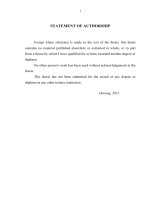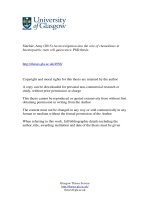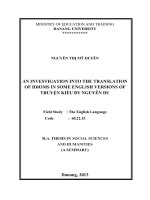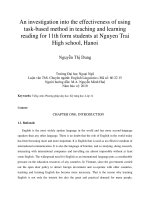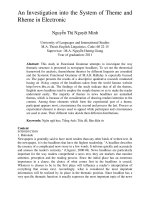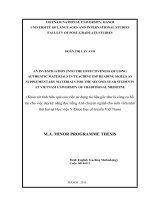An investigation into conceptual metaphors of love in poems by william wordsworth
Bạn đang xem bản rút gọn của tài liệu. Xem và tải ngay bản đầy đủ của tài liệu tại đây (305.51 KB, 26 trang )
MINISTRY OF EDUCATION AND TRAINING
THE UNIVERSITY OF DANANG
LÊ THỊ MỸ TRINH
AN INVESTIGATION INTO CONCEPTUAL
METAPHORS OF LOVE IN POEMS
BY WILLIAM WORDSWORTH
Field: THE ENGLISH LANGUAGE
Code:
60.22.15
MASTER THESIS IN THE SOCIAL SCIENCES AND
HUMANITIES
(A SUMMARY)
DANANG, 2013
The thesis has been completed at the College of
Foreign Languages, Danang University
Supervisor : Assoc. Prof. Dr. TRƯƠNG VIÊN
Examiner 1: Assoc. Prof. Dr. Phan Văn Hòa
Examiner 2: Dr. Trương Bạch Lê
The thesis was orally defended at the Examining Board at the
University of Da Nang
Time : 9 / June / 2013
Venue: Danang University
The original of the thesis is accessible for purpose of reference at:
- The College of Foreign Language Library, Danang University
- The Information Resources Centre, Danang University
1
CHAPTER 1
INTRODUCTION
1.1. RATIONALE
Communication is always considered the most important
function of language. There are a number of rhetoric devices such as
metaphor, simile and metonomy and metaphor is widely used in
many fields: literature, music and especially in poetry. Poetry also
helps us have an optimist look at this beautiful life.
However, perceiving a poem is not simple and easy. If we
perceive a poem deeply, we will have chance to understand all
human’s sentiments.
Love is an indispensable part of our life and an endless
inspiration for poets, novelists and composers. Therefore, poetry has
taken a chance to bridge people together by its love messages. Thus,
it is not easy to transfer, understand, explain and discover all
concepts of it through poems.
William Wordsworth is a famous poem. Reading his poems,
we are easy to find the beauty of the nature and the feeling of the
poet toward nature. Moreover, his love for human always makes us
sentimental. In his poems, he uses a range of various images or
events in daily life to conceptualize Love. We call it “metaphor”.
This thesis takes the theory on metaphor by Lakoff and his
colleagues in Metaphor We Live By as the theoretical base.
Conceptual metaphor in Lakoff and his colleagues’ view is is
mapping across conceptual domains, from source to target, and
normally from the concrete to the more abstract. We can consider the
following example of metaphor relating to Love:
2
And then my heart with pleasure fills
And dances with the daffodils (Daffodils)
The writer uses orientational metaphor to talk about his Love
to the nature. In these two lines of poem, he uses the conceptual
metaphor LOVE IS A HUMAN ACTIVITY to describe the action
DANCE of the daffodils through the image “dance”, an activity of
human.
For the above reasons, I decided to choose the study on the
topic “An Investigation Into Conceptual Metaphors of Love in Poems
by William Wordsworth”.
1.2. AIMS AND OBJECTIVES
1.2.1. Aims of the study
To discover and explain expressions of conceptual metaphors
in poems.
1.2.2. Objectives of the study
a. To analyze the conceptual metaphors used for describing
“love” in poems by Wordsworth.
b. To discover and explain expressions of conceptual
metaphors used for describing “love” in poems.
c. To make some suggestions for teaching, learning and
translating conceptual metaphors.
1.3. RESEARCH QUESTIONS
a. What are conceptual metaphors used for describing love in
Wordsworth’s poetry?
b. What are the implications for the use of conceptual
metaphors in teaching, learning and translating?
3
1.4. SIGNIFICANCE OF THE STUDY
To master how to apply the conceptual metaphors to
understand about poems thoroughly.
1.5. SCOPE OF THE STUDY
This thesis takes lines of poem relating to Love in
Wordsworth’s poetry as the object to study.
1.6. ORGANIZATION OF THE STUDY
Chapter 1: consists of the rationale, the aims and objectives,
the research questions, the significance of the study the scope of the
study, and the organization of the study.
Chapter 2: covers a review the previous studies related to the
topic. Moreover, theoretical background is the definitions of
metaphor and Love as well as the roles, the types of metaphor in
Love indicated in this chapter, William Wordsworth’s biography and
his works.
Chapter 3: has research design, research methodology,
research procedures, data collection, data analysis and summary.
Chapter 4: contains the discussion and findings of the
linguistic features of the metaphorical expressions in English poems
by William Wordsworth.
Chapter 5: includes conclusion the thesis, the implications for
poems and conceptual metaphors in teaching, learning and
translating, the limitations of the study, the suggestions for further
research.
4
CHAPTER 2
LITERATURE REVIEW AND THEORETICAL
BACKGROUND
2.1. LITERATURE REVIEW
2.2. THEORETICAL BACKGROUND
2.2.1. Cognitive Semantics
a. Definition of Cognitive Semantics
Peter Gardenfors and Gens Allwood [1] give two definitions
of cognition: narrow definition and broad definition.
b. Tenets of Cognitive Semantics
(1) Meaning is conceptualization in a cognitive model. (2)
Cognitive models are mainly perceptual determined. (3) Semantic
elements are on the spatial or topological objects. (4) Cognitive
models are primarily imaged-schematic. (5) Semantics is primary to
syntax and partly determines it. (6) Concepts show prototype effects.
2.2.2. Metaphors
a. Traditional Theories of Metaphor
A metaphor consists of two main parts: the tenor and the
vehicle, according to I.A Richard [24]. The tenor is the subject to
which the metaphor is applied. The vehicle is the metaphorical term
through which the tenor is applied.
b. Metaphors in the Views of Cognitive Linguistics
Cognitive linguists like Lakoff and Johnson open a new view
of metaphor called Conceptual Metaphor.
In cognitive linguistics, the tenor and the vehicle are also
known as target and source. Metaphors are named using the
typographical convention “Target is Source”. In a conceptual
5
metaphor, the elements of an extended metaphor constitute the
metaphor’s mapping.
Conceptual metaphor theory confirms that few or even no
abstract notions can be talked about without metaphor. Lakoff and
Johnson [16] identify four basic types of conceptual metaphors.
These are structural metaphors, orientational metaphors, ontological
metaphors and conduit metaphors
c. The Cognitive Account of Poetic Metaphors
Lakoff and Turner [15] explicate the ways in which poets aim
at poetic effects from conventional cognitive metaphors. According
to them, these are four techniques: extending a conventional
metaphor in a novel way, elaborating the image-schemas;
questioning the limitations of conventional metaphors and offering a
new one, and forming composite metaphors.
Cognitive studies of poetry have classified the fact that poetic
texts can be metaphoric on two levels. On the other hand, they
display local metaphors, which manifest themselves locally as
linguistic expressions in the text. They are based on both conceptual
mappings, image mapping and a combination of both. This is the
case of text as global metaphor. Namely, the text presents a source
which is to be mapped onto a target of larger concern.
2.2.3. Conceptual Metaphors
In a conceptual metaphor, CONCEPTUAL DOMAIN (A) IS
CONCEPTUAL DOMAIN (B) can be used as a convenient way to
capture this view of metaphor. When people understand life in terms
of a journey, the conceptual metaphor LIFE IS A JOURNEY is
drawn onto understand the concept of life. It is realized by
6
metaphorical linguistic expressions such as the following:
- He’s without direction in life.
- I’m where I want to be in life.
- I’m at a crossroad in my life.
The way we speak about life in English is similar to the way
we speak about journey. People use the concept of journey to
understand the highly abstract concept of life.
The two domains involved in a conceptual metaphor are called
the target domain and the source domain.
A set of systematic correspondences between the source and
the target is the basis for conceptual metaphors. These conceptual
correspondences are named as mappings. Take the conceptual
metaphor LIFE IS A JOURNEY as an example.
From the example above, we can see that the constituent
elements of the conceptualdomain JOURNEY are in systematic
correspondence with constituent elements of the conceptual domain
LIFE.
2.2.4. Classification of Conceptual Metaphors
a. Structural Metaphors
Structural metaphor is a conventional metaphor in which one
concept is understood and expressed in terms of another structure.
Lakoff and Johnson [16] allow us to use highly structured clearly
delineated concept to structure another. Let us consider the example
LOVE IS A JOURNEY, some metaphorical expressions [16] can be
drawn are:
o This relationship is foundering.
o We are going nowhere.
7
o This relationship is a dead – end street.
The expressions from vocabulary of JOURNEY, e.g.,
foundering, going, dead-end street, form a systematic way of talking
about the essence of love is a travel or journey and lovers are
travelers.
In short, LOVE is understood as a JOURNEY in which lovers
have to suffer and overcome many difficulties in their love in order
to be together.
b. Orientational Metaphors
This kind of metaphor has things to do with the spatial
relationship which is made for a concept based on our experience of
the physical space we have such as: up-down, in-out, front-back, onoff, deep-shallow, central-peripheral.
For examples CONSCIOUS IS UP, UNCONSCIOUS IS
DOWN
o Wake up!
o Get up!
o I am up already.
……
16, p.47]
Lakoff and Johnson [16] see the physical state in the fact that
someone who is conscious has a rising state and someone who is
unconscious has a falling state.
c. Ontological Metaphors
The third type of conceptual metaphor is the ontological
metaphors where experience can be identified and categorized as
entities and substances restricted by a surface. This type is based on
the experience with physical objects. We can see this through the
8
following examples:
o My fear of insects is driving my wife crazy.
o That was a beautiful catch.
o We are working toward peace.
…..
[16, p.28]
In the above examples, the purpose of referring fear of insects
– driving my wife crazy; that – beautiful catch; working toward –
peace; is obtained.
The last purpose according to Lakoff and Johnson is
identifying causes. For examples:
o The pressure of his responsibilities caused his breakdown.
o Our influence in the world has declined because of our lack
of moral fiber.
o Internal dissertation cost them the pennant.
……
[16, p.28]
Another concept is the container metaphors. Human beings
are containers with boundaries and an orientation of inside and
outside. This orientation is not only used for physical objects but also
nonphysical objects. These nonphysical objects can be understood by
transforming them into physical ones. We can take the below
statements as examples:
o See you in the next talk.
o You can see his sorrow in his letter.
o If you can’t get out of the trouble, you will never be happy.
16, p.31]
These examples show us that states such as talk; letter;
trouble; love are container objects.
9
On the other hand, activities in general are viewed
metaphorically as substances:
o How did Jerry get out of washing the windows?
o Outside of washing the windows, what else did you do?
o How much window washing did you do?
….
[16, p.31]
On the other hand, events and actions are considered as objects:
o Did you see the race?
o The finish of the race was really exciting.
[16, p.31]
Furthermore, ontological metaphor is the type of metaphor that
describes something as a person. For examples:
o My love betrayed me.
o The shop will close in two more days.
o What he has done say everything.
d. Conduit Metaphors
Conduit metaphors is a conventional metaphor in which ideas
are represented as objects, words as containers, and communication
as sending the ideas in the words, so that the addressee may get the
ideas out of the words. Let’s see the following examples:
o It’s hard to get that ideas across to him.
o I gave you that idea.
o Your reason came through to us.
Here, we can see that IDEAS; THOUGHTS; REASONs and
MEANING are considered as OBJECTS so that people can get;
gave; have; pack; put; capture; stuff; force... and LINGUISTIC
EXPRESSIONS like WORDS, SENTENCES... as CONTAINERS to
10
hold
ideas,
thoughts,
reasons,
meaning...
and
also
COMMUNICATION is a process of SENDING ideas, thoughts,
reasons, meaning... into words.
2.2.5. Metaphoric Mappings
Source domain: the conceptual domain from which we draw
metaphorical expressions. Source domain is classified into the
following main types: human being, natural world and social events.
a) Human being:
o Part of the body (hand, heart, head...):
CPU is the heart of the computer.
o Famous people as a famous singer, actor, politician, player,
scientist...:He is our Pele.
o Buildings (house, castle, temple, church...): Love is a castle.
b) Natural world and natural events:
o Animals and insects: He hides himself like a rat.
o Plants: Diana is a rose of England.
Natural events: You are the suns in my heart.
c) Social events such as war, argument, peace...Love is war.
Target domain: the conceptual domain that we try to
understand. The basis target domains are:
a) Naming expressions such as name of a person, place,
animal...:Paris is the center of fashion.
b) Abstract expressions in feelings, morality, intelligence, will:
Love is a journey.
c) Abstract expressions in people’s philosophy and outlook of
life: Life is a flame.
A mapping is the systematic set of correspondences that exist
11
between constituent elements of the source and the target domain.
Many elements of target concepts come from source domains and are
not preexisting. To know a conceptual metaphor is to know the set of
mappings that applies to a given source – target pairing.
a. Mapping principles
In the Conceptual Metaphor Theory, metaphor is defined as “a
cross-domain mapping in the conceptual system”. The metaphor
involves two domains, a source domain and a target domain. The
latter is understood in terms of the former, so the convention is to
call each mapping as “target-domain is source domain” or “targetdomain as source-domain”.
Each metaphorical mapping consists of: Slots in the source
domain schema, relations in the source domain, properties in the
source domain, knowledge in the source domain.
SOURCE
DOMAIN
TARGET
DOMAIN
MAPPING
SLOTS
SLOTS
RELATIONS
RELATIONS
PROPERTIES
PROPERTIES
KNOWLEDGE
KNOWLEDGE
(See Lakoff (1993), The Conceptual Metaphor Theory, P.203)
Figure 2.1. Metaphorical mappings
12
b. Mapping Types: conceptual mappings and image mappings
Conceptual mappings: Let us consider LIFE AS JOURNEY
metaphor. Knowing the structure of this metaphor means knowing a
number of correspondences between the two conceptual domains of
life and journeys, such as these mappings:
o The person leading life à a traveler
o His purposes à destinations
o The means for achieving purposes à routes
o Difficulties in life à impediments to travel
o Counselors à guides
o Progress à the distances traveled
o Things you gauge your progress by à landmarks
o Choices in life à crossroads
Image mappings:
Besides, there is another major type of metaphor that maps
conventional mental images onto others by vitue of their internal
structure; let look at the following expression:
•
My wife... whose waist is an hourglass
[Appendix 15]
We understand this as an image mapping in which the mental
image of an hourglass is mapped onto that of the wife, with the
central narrow portion of the hourglass corresponding to the wife’s
waist. Note that the words do not tell us which part of the hourglass
to map onto the waist, or event that it only part of the hourglass
shape that corresponds to the waist. The words are prompt for us to
perform mapping from one conventional image to another at the
conceptual level.
13
Up to now, we have discussed cases a source image is mapped
onto a target image which contains as an image. A source image
might also be mapped onto a target domain in order to create am
image in the target domain.
2.3. SUMMARY
Firstly, Cognitive semantics is a part of the cognitive linguistics
movement and as part of the field of cognitive linguistics the
cognitive semantics approach rejects the formal traditional separation
of linguistics into phonology, syntax, pragmatics, etc.
Secondly, traditional theories of metaphor are completely
different from contemporary theories of metaphor.
Thirdly, Lakoff shows four types of conceptual metaphors.
Finally, the studies of Lakoff in metaphoric mappings provide
us the useful mapping disciplines and mapping types. An image
metaphor maps one mental image from one source of knowledge
onto mental images from a different source. They are different to
mappings in conceptual mapping which may map many concepts in
the source onto corresponding concepts in the target domain.
To achieve the aims, objectives and success in this research, the
methods and the procedures of the research are crucially important.
All of these are going to be discussed in chapter Three.
2.4. W. WORDSWORTH’S BIOGRAPHY AND WORKS
2.5. DEFINITION OF LOVE
14
CHAPTER 3
METHODOLOGY AND PROCEDURES
3.1. RESEARCH DESIGN
3.2. RESEARCH METHODOLOGYT
3.3. RESEARCH PROCEDURES
3.4. DATA COLLECTION
3.5. DATA ANALYSIS
3.6. SUMMARY
CHAPTER 4
FINDINGS AND DISCUSSIONS
There
are
some
conceptual
metaphors:
UP/
DOWN,
CONTAINER, LIGHT, PLANT, SUN, WAR, CAPTIVE BEING,
LIFE, HEAVEN, MOTION, JOURNEY, HUMAN ACTIVITY.
4.1. LOVE IS UP / DOWN
Almost lines of poems are used with a number of these words
“higher”, “full”, “fostering”, … to talk about his happiness and
joyfulness. In English, feeling happy is like being high up or moving
upward. They used to express happiness or joy being quite logical to
the conceptual metaphor “HAPPINESS IS UP”.
Nature comes from Wordsworth’s poetry by chance. Nature is
the same as a lively picture with glitter colours. He feels peaceful
when he admires the beauty of Nature. The more he gazed, the more
beautiful he feels.
(1) No picture of mere memory ever looked
43]
So fair; and while upon the fancied scene
I gazed with growing love, a higher power
[Appendix
15
Than Fancy gave assurance of some work
Of glory there forthwith to be begun,
Perhaps too there performed. Thus long I mused,
We can feel metaphor is up or sadness from a cognitive
linguistic perspective. In William Wordsworth’s poetry, love is down
is often expressed through the word “sadness”. We can identify the
following source domains:
(13)But, see, the evening star comes forth
[Appendix
258]
To bed the children must depart;
A moment's heaviness they feel,
A sadness at the heart;
Basing on the theory orientational metaphor of Lakoff and
Johnson, we can perceive that the physical state in the fact that
someone who is conscious has a rising state and someone who is
unconscious has a falling state.
4.2. LOVE IS A CONTAINER
It is difficult to find this kind of metaphor in the poetry. We
activate in our mind one of the most conventional metaphors. Love is
depicted as a contained object within a container. Generally, the
contained object is portraited as a well. The container schema is
adopted in love metaphors when the object “well”is viewed as a
container, with an orientation and the emotion of love is considered
in the container.
(38)
A well of love--it may be deep-I trust it is,--and never dry:
What matter? If the waters sleep
[Appendix 2]
16
In silence and obscurity.
--Such change, and at the very door
Of my fond heart, hath made me poor.
Considering these lines “ A well of love”, as they appear in the
lines of poems above. We understand these clauses contain the
metaphor that love and hope are filling in his heart. The sample
shows us the most frequently used for source domain for describing
love, the body is a container for the love. Love here is an occurrence
inside the body. From these samples, we can see that love is
conceptualized as being inside the body CONTAINER. LOVE IS A
CONTAINER suggestd that the body of a happy person is the
container of the feeling LOVE. Thanks to examining “Love is a
container” metaphor, we seem to recognize that this kind of
orientational metaphor used in William Wordsworth’s poetry.
4.3. LOVE IS LIGHT
The metaphorical source domains of “light” seem to behave in
a uniform way, in which they apply to happiness. We should notice
that all positive feelings are warm and light. This can be explained
by Wordsworth’s perception of light, light is conceptualized as
bright, brilliant, noble or like Heaven. By using the word “light”, he
shows his love when he feels everything better and the evil is left
behind:
(42)
Now am I fairly safe to-night--
[Appendix 291]
And with proud cause my heart is light:
I trespassed lately worse than ever—
But Heaven has blest a good endeavour;
And, to my soul's content, I find
17
The evil One is left behind.
Obviously, the LIGHT metaphor also hightlights the positive
evaluation of love. The LIGHT metaphor is based on the source
domain “up” to indicate the target domain “love” according to
conceptual metaphors. This is the demonstration of orientational
metaphor of love.
4.4. LOVE IS A PLANT
All the love concepts analyzed are common ly comprehended
in terms of plants. The PLANT metaphors map different stages of
plant growth onto the stages of love development. They also
hightlight the intensity and cause aspects of the love they
characterize. There is a perceived similarity between the source and
target domain of such love metaphors. Both plants and love come
into existence, develop and fade away. This makes it possible for us
to map the PLANT source domain onto kinds of various loves. As as
illustration, let us look at the following lines of poem where love is
described as some properties of a plant:
(44)
WHY art thou silent! Is thy love a plant
[Appendix
222]
Of such weak fibre that the treacherous air
Of absence withers what was once so fair?
Is there no debt to pay, no boon to grant?
Love in this poem is expressed through the expression of a
plant needing taking care of carefully. From this poem, we can see
that love is an abstract concept while a plant is a concrete one.
William Wordsworth is very successful in conceptualizing love as a
plant.
18
4.5. LOVE IS THE SUN
The love-sun is often conceptualized in terms of space. The
details are really interesting. The lover is stationary, is the deictic
center. When talking about the sun, people always think of burn,
rise…. The love concepts can take heat – fire as their source domain.
With the word “burn”, “rise”, we can conceptualize love as having a
beginning, existence and an end. In the following example, love is
existent and love is intense.
(45)
He loved the breathing air,
[Appendix
22]
He loved the sun, but if it rise
Or set, to him where now he lies,
Brings not a moment's care.
Alas! what idle words; but take
The Dirge which for our Master's sake
And yours, love prompted me to make.
The ORIENTATION metaphor is applied successfully to
describe LOVE IS THE SUN.
4.6. LOVE IS A WAR
William Wordsworth has found out the correspondences
between “war” and “love”. We can rely on such correspondences to
set “love is a war” mapping.
This is embodied through the word “conflict”. Here, William
Wordsworth describes the war between Nature with human, among
human with each other… to find the peace for the earth or for human
itseft. In his opinion, Nature is considered as human with emotions:
19
happiness, sadness, anger… Each line of poem is mourning for
personhood.
(47)
Sweet Mercy! to the gates of Heave [Appendix 157]
This Minstrel lead, his sins forgiven;
The rueful conflict, the heart riven
With vain endeavour,
And memory of Earth's bitter leaven,
Effaced for ever.
As mentioned above, once upon time people knew how to
fight to achieve the love. In these examples, the poet uses ontological
metaphors to identify aspects.
4.7. LOVE IS A CAPTIVE BEING
In love, human are forced to do something they do not want.
Maybe they are in captive state as animals but they are captured in
their own love. Human’s trying to get free from this capture mapped
onto the captive being’s trying to escape from the cage. They become
prisoners that must work actively. Look at some following examples:
(58)
Who, being loved, in love no bounds dost know,
And say'st, when we forsake thee, 'Let them go!'
Thou easy-hearted Thing, with thy wild race
Of weeds and flowers, till we return be slow,
And travel with the year at a soft pace.
In this metaphor mapping, target domain LOVE is mapped onto
source domain CAPTIVE BEING. The poem uses ontological
metaphor to describe and create new based on conceptual metaphor.
4.8. LOVE IS LIFE
20
Love is always lively and in his eyes, love can live as human
with a murmur of conversation. In his mind, love is sparkling with a
lot of colours. It hides both happiness and sadness. His love for
nature is diverse and changeable very much.
(62)
What happy moments did I count!
[Appendix
2]
Blest was I then all bliss above!
Now, for that consecrated fount
Of murmuring, sparkling, living love,
What have I? Shall I dare to tell?
A comfortless and hidden well.
In LOVE IS LIFE metaphor, the love also has a physical life
as a human. In order to exist and develop, love has various activities.
Through metaphors, love becomes an entity that has cognition and
consciousness to act consciously like a human.
4.9. LOVE IS HEAVEN
The heaven is thought the wonderful place where everyone
always wants to reach after the death. Let’s look at the procedure of
transferring meanings as follow. “Love” and “heaven” seem to have
a lot of properties in common. Heaven is believed to be a beautiful
and holy place where everyone can live happily and their dreams
properly come true. For example:
(72)
His hope is treacherous only whose love dies
[Appendix104]
With beauty, which is varying every hour;
But, in chaste hearts uninfluenced by the power
Of outward change, there blooms a deathless flower,
That breathes on earth the air of paradise.
21
Heaven makes love become a bright picture with flower, field,
grove, mist, river…. With the sharp pen, Wordsworth touches all the
cell of nature in the sunrise. The mist and the shade disappear
quickly and all the sights of nature seem to be up stretched to
welcome a new day. The poem captures the suble self-motion of
nature and leaves readers beautiful impression. Here LOVE is
conceptualized according to the ontological metaphor to refer to the
result of love is heaven.
4.10. LOVE IS MOTION
This source domain occurs in love. Movement involves
changing of location or process for insistence in a container. In the
conceptual metaphor LOVE IS MOTION, love is understood in
terms of motion. For instance:
(80)
This picture from nature may seem to depart, [Appendix 1]
Yet the Man would at once run away with your HEART
And I for five centuries right gladly would be
Such an odd such a kind happy creature as he.
LOVE IS MOTION metaphor mentioned above helps us to talk
about love in many ways. By using the verb “run away” the poet wants to
transfer a message of the beginning and the ending of love. These words
of motion are used to conceptualize the instability of love.
4.11. LOVE IS A JOURNEY
“Love is a journey” mapping is a set of ontological
correspondences between “journey” and “love”. Because love is a
journey, there is a way that lovers are traveling on. This way has a start or
an end point where lovers start or end their relationship where they
achieve the goals of their love. Let us consider the example below:
22
(83)
These have we, and a thousand nooks of earth
[Appendix 272]
Have also these, but nowhere else is found,
Nowhere (or is it fancy?) can be found
The one sensation that is here; 'tis here,
Here as it found its way into my heart
In childhood, here as it abides by day,
By night, here only; or in chosen minds
That take it with them hence, where'er they go.
All above lines of poems are Wordsworth’s faithful words to
tell about his childhood. They make special and memorable points in
his poems.
4.12. LOVE IS A HUMAN ACTIVITY
Human have different activities so that they respond for
human’s need everyday such as: eat, drink, dance, sing…and so on.
Love does, too. Love can join in activities above in order to make
itseft more interesting and lovelier. In these lines of poems, “roused”
means “wake up” and it is a daily activities of human.
(88) The heart that first had roused him. Youth maintains, [Appendix 41]
In all conditions of society,
Communion more direct and intimate
With Nature,--hence, ofttimes, with reason too—
Table 3.1. Frequency of Conceptual Metaphors for Love
in William Wordsworth’s poetry
1
2
3
Conceptual Metaphors
Love is up / down
Love is a container
Love is light
Occurrence Total
37
4
2
Percentage
33,63
3,63
1,81
23
4
5
6
7
8
9
10
11
12
Love is a plant
Love is the sun
Love is a war
Love is a captive being
Love is life
Love is heaven
Love is motion
Love is a journey
Love is human activity
Total
1
2
11
4
9
9
3
5
23
110
0,90
1,81
10
3,63
8,18
8,18
2,72
4,54
20,90
100
In the LOVE IS A HUMAN ACTIVITY metaphor, love is
understood in term of human activity. Love can take part in activities
like other living entities.
Statitics shows that this is the most common metaphor of love
in poems with 33,63% of the metaphorical expressions belonging to
LOVE IS UP/ DOWN metaphor, and the second common LOVE IS
HUMAN
ACTIVITY
metaphors
with
20,72%.
HUMAN
ACTIVITY is as a source domain for LOVE. The third, as we know,
LOVE IS A WAR metaphor with the rate of occurrence is 10%. The
interesting finding is that there are expressions of captive being as a
container for love found in poems by William Wordsworth. LOVE
IS CAPTIVE BEING , LOVE IS LIFE , LOVE IS HEAVEN, LOVE
IS MOTION and LOVE IS A JOURNEY only occur with a small
number. At last, the new kind of metaphor is LOVE IS HUMAN
ACTIVITY occurring 20.90%. All of those, LOVE IS A CAPTIVE
BEING and LOVE IS A HUMAN ACTIVITY are the new kinds of
metaphor. All samples above are mainly talking about the human and
human’s poverty.
